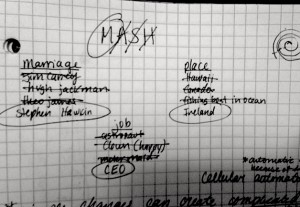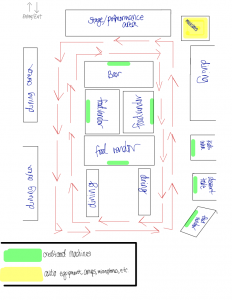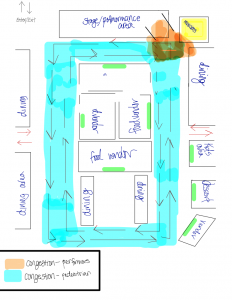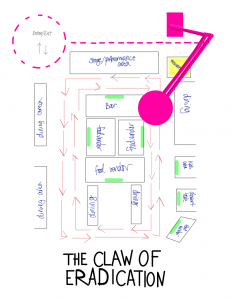There is Only Software by Lev Manovich, Response
Posted: September 9, 2015 Filed under: Alexandra Stilianos, Reading Responses 1 Comment »Depending on which software you use to access it, what you can do with the same digital file can change dramatically.
Of course it is, in the eyes of a designer or programmer of course this realization is apparent but if ‘we’ are designing, creating, devising for the ‘masses’ the responsibility changes hands. In the same way that your experience with software can alter your experience, the same goes (in my opinion) on your lack of awareness of the capabilities therein. There is only software for the minority in the know of the in’s and outs of programming, for the masses who use the media- it is simply media, right?
To reverse back to Baudrillard:
“all we have now are simulations of reality (which aren’t any more or less real than the realities they simulate.)”
Jean Baudrillard by Doug Mann, Response
Posted: September 9, 2015 Filed under: Alexandra Stilianos, Reading Responses Leave a comment »“Death of the real” – “Simulacrum” – “Desert of real”
No matter which way he phrases the theory it is clear, we all are constantly and relentlessly immersed in the culture we live in. I have problem with any various sweeping argument in general, including Mann’s. I am also curious to place this article in the (near or distant) past since it has no date, and his pop culture references are Friends and Lara Croft.
While his refurbishing of ‘simulacrum’ is interesting, I think even a mildly self-aware person has the ability to speak about a fictional person/character in the context of the show (in the TV example.) The disillusioned minority who cannot would be similar to Brooke Shields cameo on the aforementioned show, Friends, where she believe Joey (Matt Leblanc) to actually be his soap opera character, Drake. META.
“Loss of reality isn’t so hard to understand but difficult for some of us to swallow.” So maybe, I am also just a lost lamb and this desert is too real for me to accept. *shrugs, turns Netflix back on*
PP1: Greek Festival/Claw of Eradication
Posted: September 7, 2015 Filed under: Alexandra Stilianos, Pressure Project I Leave a comment »Get started: When asked to go to a public place and make hypothetical choices that will affect the general population, the urge to (theoretically) choose malevolency was too strong an urge to ignore. Also, first instincts were embraced and explored.
Location: Columbus Greek Festival, Courtyard
Food: My favorite Greek pastry, galaktoboureko- Delicious
Map: I choose to observe the courtyard area of the festival which served multiple functions. The east side of the lot held the entrance, a performance space for folk dancing and a small stage with a band and various musicians. The center and rest of the space held portable tables for dining and various food/alcohol vendors. The flow of traffic moved erratically (as would any festival) but most often it was cyclical. Existing major technologies were listed in the legend but also included my main focus/perpetrator: the cellphone.
Notes: The highest areas of congestion were around all the vendors as one would suspect but the corner that shared space between access to the bar, stage, musicians and dining area was the most dense. Not only because of sheer numbers, alcohol consumption and children running erratically waiting to perform but a common 2015 problem: the multitasking text and walk combo. While this problem was illuminated in this space, it is a common problems in all areas of the festival (not to mention shopping malls, side walks, the oval, etc.). While hardly anyone can admit to being innocent of this crime, it is more problematic in a setting such as a small festival than it is in a large, public area. For that reason, I choose to devise a system that was effective, isolated and also a bit hilariously cruel.
Devise:
“The class is our master, the claw chooses who will stay and who will go.”- Alien’s, Toy Story
I devised a crane of sorts that can eradicate people who have, in a congested public space, become an obstruction because of their absorption in their devices (particularly, smartphones.) This would be done by a sensor who reads body posture, as well as other factors, and in a sort-of magnetic field, alien abduction-esque way, be lifted from the space and returned to the entrance where they can re-enter after disregarding their distraction.
I used the ability to ignore actualities of creating this device freely but did determine three factors that needed to be taken in account when determining who gets ejected. They are:
- Device in hand
- Curvature of cervical spine
- Forward mobility
The Claw would have a system of sensors that had the ability to read these various requirements and would only eject perpetrators that met all three. The first would require some sort of heat sensor that could detect the phone was out of a pocket or purse and touching human skin. Then it would also be able to detect the curvature of the cervical spine, since a person can walk and talk on the phone more effectively than when they are hunched over staring at the ground. The final requirement is the necessity for the subject/victim to be in a forward motion, a considerate person can step aside out of a traffic pattern to complete their cellular duties, which should not be punished.
Conclusion: While this solution is highly impractical in the ‘real’ world, it was enjoyable to not only observe and find a solution, it also gave me a sinister satisfaction to deal with a pet peeve of mine. All the while, with a devising experiential mind.
OPA!
M(ansion) A(partment) S(hack) H(ouse)
Posted: September 7, 2015 Filed under: Alexandra Stilianos Leave a comment »A twist on the classic fortune-telling list game.
The original MASH is played by making lists of various aspects/milestones of ones life (marriage, job, home, kids, etc.) in separate categories, picking a number at random then using that number to cross off potential ‘candidates’ one by one until each section has only one option left. The method we used to decide how many jumps to take until a candidate was crossed off included me drawing a spiral until Sarah said, ‘Stop’ and counting the number of rings.

Original constant: spiral in UR shows 5 marks starting from center to detonate a cross-off every 5 moves.
In our (truncated) controlled, original version of the game Sarah can look forward to marrying Stephen Hawking, living in a mansion in Ireland and be employed as a CEO. Not too shabby a life, Sarah!
Next we decided to take out the constraints of having all the corresponding potential categories in the same list. We randomized them in a word cloud, used the spiral method to find a number and cross off at random until only 4 remained. This added the possibility that a player could have multiple jobs but nowhere to live (and all the variants therein).

In this version Sarah can look forward to having no job or income but traveling the country living in apartments in California and Kansas with our fellow classmate, Josh Poston.
I very much enjoyed the ‘risk’ involved in the world cloud set up of the game. In the original, making some of the categorical choices unappealing left some risk but the stakes are higher when all these ‘goals’ are not necessarily guaranteed. We ran into a problem when in the second version, which was at times it was difficult to be unbiased when ‘randomly’ crossing off choices. An amendment which included still putting the contenders in a list, but one long continuous and arbitrary one adds the element of organization with the suspense of the intended outcome.
All in all: we are the future.


